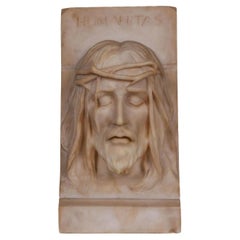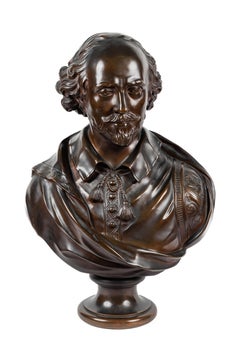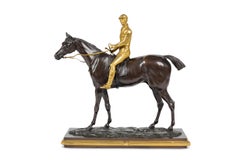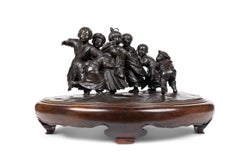Want more images or videos?
Request additional images or videos from the seller
1 of 17
A Monumental Orientalist Bronze Sculpture "Cavalier Arabe" After Emile Guillemin1950
1950
$40,000List Price
About the Item
- Creation Year:1950
- Dimensions:Height: 44 in (111.76 cm)Width: 32 in (81.28 cm)Depth: 16 in (40.64 cm)
- Medium:
- Movement & Style:
- After:Émile Guillemin (1841 - 1907)
- Period:
- Condition:Wear consistent with age and use.
- Gallery Location:Queens, NY
- Reference Number:1stDibs: LU115128714452
About the Seller
5.0
Platinum Seller
Premium sellers with a 4.7+ rating and 24-hour response times
Established in 1980
1stDibs seller since 2019
15 sales on 1stDibs
Authenticity Guarantee
In the unlikely event there’s an issue with an item’s authenticity, contact us within 1 year for a full refund. DetailsMoney-Back Guarantee
If your item is not as described, is damaged in transit, or does not arrive, contact us within 7 days for a full refund. Details24-Hour Cancellation
You have a 24-hour grace period in which to reconsider your purchase, with no questions asked.Vetted Professional Sellers
Our world-class sellers must adhere to strict standards for service and quality, maintaining the integrity of our listings.Price-Match Guarantee
If you find that a seller listed the same item for a lower price elsewhere, we’ll match it.Trusted Global Delivery
Our best-in-class carrier network provides specialized shipping options worldwide, including custom delivery.You May Also Like
Baroque Roman sculptor - 17th century bronze sculpture - Mars Warrior
Located in Varmo, IT
Gilded bronze sculpture - Mars, god of War. Rome, 17th century.
9 x 9 x h 31 cm.
Entirely in cast, chiseled and gilded bronze, resting on an ebonized wooden pedestal decorated with...
Category
Mid-17th Century Baroque Figurative Sculptures
Materials
Bronze
$4,211 Sale Price
41% Off
Free Shipping
H 12.21 in W 3.55 in D 3.55 in
The Rape of Sabine Iconic Bronze Sculpture 1930
Located in Rome, IT
Fine Group of Sculptures in Bronze after Jean de Boulogne (Giambologna)
The torturously twisting Rape of the Sabine Women is one of the finest and most technically difficult sculptures in the world. Three intertwined bodies, two men and a woman, spiral upwards as the woman tries to escape the clutches of the younger man standing over the older one. It is an absolute masterpiece by the Flemish sculptor Giambologna.
After the original in Florence’s Loggia dei Lanzi, Piazza della Signoria...
Category
1920s Mannerist Figurative Sculptures
Materials
Bronze
The Rape of Sabine Iconic Bronze Sculpture 1930
Located in Rome, IT
Fine Group of Sculptures in Bronze after Jean de Boulogne (Giambologna)
The torturously twisting Rape of the Sabine Women is one of the finest and most technically difficult sculptures in the world. Three intertwined bodies, two men and a woman, spiral upwards as the woman tries to escape the clutches of the younger man standing over the older one. It is an absolute masterpiece by the Flemish sculptor Giambologna.
After the original in Florence’s Loggia dei Lanzi, Piazza della Signoria...
Category
1920s Mannerist Figurative Sculptures
Materials
Bronze
The Rape of Sabine Iconic Bronze Sculpture 1930
Located in Rome, IT
Fine Group of Sculptures in Bronze after Jean de Boulogne (Giambologna)
The torturously twisting Rape of the Sabine Women is one of the finest and most technically difficult sculpt...
Category
1920s Mannerist Figurative Sculptures
Materials
Bronze
$6,713 Sale Price
30% Off
H 35.44 in W 8.27 in D 8.27 in
Maqueta las toninas
Located in Miami, FL
Maqueta las Toninas, 1944
BMY-022, 1970
Edition 1/25
Bronze
22 x 22 x 10 cm
8.6 x 8.6 x 3.9 in
ABOUT THE ARTIST
Narvaez was born in Porlamar, Venezuela, in 1905; he was the fifth son of eleven siblings; his parents were Jose Lorenzo Narvaez and Vicenta Rivera. Don José Lorenzo, a multifaceted and creative man, sowed the seed of creativity in his son. “My father did not fit in with his fantasies of cabinetmaker, bricklayer, master builder, and self-taught architect.”1 From an early age, Francis was led to the artistic activity, he traced, carved, made replicas of the furniture and the saints restored by his father.
In 1920 he obtained his first professional assignment, a San Rafael for the Church of Carupano, and, in 1922, his father authorized him to travel to Caracas to pursue his studies as an artist. He studied at the atelier of Marcos Castillo, at of the Angel Cabre y Magriña and at the Academy of Fine Arts in Caracas, where he was introduced to the painters and intellectuals of the time.
In 1928 he presented his first solo exhibition at the Club Venezuela. With the money raised from the sale of the works and the support of Monsignor Sosa, and the Ministers Centeno Grau and Arcaya, he studied in Paris on a scholarship. Once there, he enrolled at the Académie Julian, where Tito Salas, Cristóbal Rojas and Arturo Michelena had also studied. It was in Paris where, unable to work in wood, he turned to stone carving. “In Paris, I didn’t have wood, so I carved a lot in stone (…), when there were demolitions I purchased chunks of stone, I would take them to the workshop and carve them.”2
His first attempts at volumetric sculptures and painting in plain colours, linked to the thematic of American miscegenation and Creole reality, can be traced back to that first trip to Paris. During his stay in the French city, Arturo Uslar Pietri, Alfredo Boulton, and Finita Vallenilla supported the artist both financially and logistically, and in February of 1930, the trio of friends arranged another exhibition for him at the Club Venezuela. Narvaez describes his exhibition as follows: “(…) in it I feel that the sculptural work is more my own, done with more assurance, a response to my pursuit of large planes, stylisation and synthesis.”3 By then, as Boulton himself noted in his book about the artist, Narvaez departed from most of the artistic traditions that prevailed by that time in Venezuela.
In 1931 he returned to Caracas and established his atelier at the Barrio Obrero in Catia. The atelier became the hub of the intellectual life of the time. “In those years, the atelier of Francisco Narvaez was the hub of the greatest Venezuelan hope. Nothing comparable to it can be found either before or since.”4
From that year onwards, exhibitions, projects, trips, and awards we multiplied. He was awarded the President of the Republic of Venezuela Prize, the National Sculpture Prize of the 1st Official Venezuelan Art Salon, and the John Boulton Prize of the 3rd Annual Venezuelan Art Salon; for the Military Academy, he produced a spectacular relief entitled La Patria.
In 1945, commissioned by the architect Carlos Raúl Villanueva, he produced two groups of sculptures known as Las Toninas, both located in the O’Leary Square. There, as he himself states, he incorporates some baroque patterns into the figures to the source itself: “It is a work of balance between the decorative requirements and the sculpture of planes and angles.”5
In 1948 he was awarded the National Painting Prize. In the same year, he was called upon by the architect Carlos Raul Villanueva to participate in the project for the arts integration in the Universidad Central de Venezuela. Francisco Narvaez’s public output continued with works such as the statue of Fermín Toro, La Educacion, La Ciencia, three murals (produced by María Luisa Tovar) for the Instituto de Medicina Experimental, El Cristo; el Atleta, the equestrian statue of General Rafael Urdaneta.
In 1953 he was appointed Director of the School of Plastic and Applied Arts, and in July of the same year, he exhibited “Francisco Narvaez, Maderas, Piedras y Bronces” (Francisco Narvaez, Woods, Stones and Bronzes) at the Museum of Fine Arts.
Narvaez is, unquestionably, one of the great Venezuelan sculptors, his work goes through various stages and interests; as the art world evolves, the artist does not remain in his initial scopes of work. His creations are not imposed by the prevailing trends or fashion but do evolve by experimenting with new materials and interests.
When one peruses the artist’s lengthy list of exhibitions, commissions, and awards, it is worth remembering the Narvaez who embark on his career as a child and who, overcoming obstacles, knew how to make the most of his curiosity. He did not settle for living off his successes. He did not remain stagnant as many creators of his environment did. Narvaez managed to understand the changes in the history of art around him. We must not overlook the fact that Francisco Narvaez is an artist amid all the changes occurring in the art world. He moves from the classics to the great transformations in the art world. It is the Europe of Picasso, Braque, Arp. He observes, he is aware of what is happening in the centres of the world of art, but between his craft and his sensitivity, the result is NARVAEZ, his stamp, and his identity.
Francisco Narvaez comes from tradition, and his first stage is linked to the classics, to the exploration of his heritage, but always with his very own language. Throughout his prolific career, he knew how to remain true to himself, without disregarding the influences of his surroundings or his artistic interests: his ability as a sculptor, his selection of materials, whether they were wood, stone or bronze; his choice of the subject of his work…His mastery and great craftsmanship are a constant that over time have made him a leading player in the history of contemporary Venezuelan and world art.
From his beginnings, no subject was foreign to him. His paintings, drawings, aquarelles, and sketches are testimony to his prolific output. Among his themes are portraits, our traditions, still lifes, and landscapes. Narvaez is an artist who represents his time. Later, he evolved towards purer and simpler forms, abandoning figurative art for short periods.
In 1956 he declared to the newspaper El Nacional: “Every day I am freeing myself, it is a soul that frees itself from the ephemeral wrappings of the circumstantial always, as well as from the inevitable weight of the anecdote. This second stage of my work is remarkably close to abstractionism, even if there are still certain figures or figurations in the sculptures that I will shortly be showing. However, pure, and absolute abstractionism, it will treat the form itself as the sole reason for its existence on the plane of artistic excellence.”6
The artistic development was his professional life. Each period of his life as an artist, he went one step further, searching, solving, seeing plenty of things and understanding how diverse expressions were transforming themselves. His hands followed his gaze and his mind, always inquisitive. He added movement to the volumes.
Arturo Uslar Pietri, “Formas Nuevas”, Cromotip editions, 1956 “Francisco Narvaez is a path: the path that Venezuelan sculpture...
Category
1940s Baroque Figurative Sculptures
Materials
Bronze
Italian Mannerist style Italian mythological figurative bronze statuette of the 20th century
Located in Florence, IT
The small bronze depicts a small seated faun, immortalized while playing a wind instrument as can be clearly seen by the puffy cheeks. is signed at the base R. Castagnino and is from...
Category
1930s Mannerist Figurative Sculptures
Materials
Bronze
$1,498
H 9.85 in W 3.94 in D 4.73 in
After Giambologna Bronze of Mercury with green patina
By Giambologna
Located in New York, NY
Mercury, circa 1700s. Bronze with green patina. Height with base: 58 cm (22 7/8 in.)
Category
Early 18th Century Baroque Figurative Sculptures
Materials
Bronze
$2,750
Free Shipping
H 22.84 in W 5.91 in D 5.91 in
Hercules and the Centaur Nessus Bronze
Located in New Orleans, LA
This extraordinary Italian bronze embodies all of the hallmarks of the very best Florentine sculptures of the 17th century. The work is crafted in the Mannerist style of the late Ren...
Category
17th Century Mannerist Figurative Sculptures
Materials
Bronze
Bronze of Pluto Abducting Proserpine after François Girardon
Located in New Orleans, LA
After François Girardon
1628-1715 French
Pluto Abducting Proserpine
Bronze
This High Baroque period composition captures the famed narrative of Pluto and Proserpine from Roman mythology. The late 17th-century patinated bronze, created after François Girardon's marble composition, captures the very moment that Pluto seizes Proserpine. The anguished goddess reaches skyward, attempting to escape the god’s grasp while Pluto’s stoic face betrays his knowledge that his ploy will succeed. This pivotal moment in the mythological tale has captured the imagination of many art historical greats, from Bernini to Rubens. François Girardon’s version of the climax demonstrates incredible finesse and artistry, modeled expertly in bronze in the present work by a later sculptor. The statue brings a twist of intertwined bodies into a dynamic frenzy, paralleling the tension of the legendary story.
In ancient Roman mythology, Proserpine, the beautiful daughter of Ceres — known as Persephone in Greek mythology — was picking flowers in the fields when she was suddenly abducted by Pluto, the god of the underworld, and taken to his kingdom. Consumed with grief, her mother Ceres, the goddess of agriculture, scorches the earth, stopping the growth of grain and fruit. Jupiter attempts to intervene and secure Proserpine’s return to earth, negotiating a compromise with Pluto and the Fates that allows Proserpine to be released for part of the year before returning to Pluto’s underworld. Proserpine’s journey back and forth is an allegory for the changing seasons; when Prosperine is with her mother, the earth warms and provides bountiful harvests. Upon her annual return to the underworld, however, the earth once again becomes cold and barren.
After returning to France after years of training in Rome, François Girardon quickly rose to become one of the greatest artists in France. He was elected a member of the Académie Royale de Peinture et de Sculpture in 1657 and would become Chancellor of the Royal Academy in 1695. The artist was approached frequently for royal commissions and Girardon’s Pluto was originally commissioned by Louis XIV for the gardens at his Palace of Versailles. It was one of four monumental marble groups intended to decorate the corners of Charles Le Brun’s never completed garden at the chateau, the Parterre d’Eau. Each group of three figures symbolized one of the four elements: earth, air, fire and water. Pluto’s association with hell made him the apt...
Category
Early 18th Century Baroque Figurative Sculptures
Materials
Bronze
$78,500
H 21.25 in W 11.25 in D 10.25 in
Angelo Basso Siren Bronze Sculpture
Located in Rochester Hills, MI
Angelo Basso (Italy, 1943 – 2011)
Siren
Signed and marked AP
Foundry Mark FAA
Beauty & Mythology Collection
Sculpture 23″ inches tall
(Base 5″ Siren 18″)
Box size 20″ x 17″ x 27...
Category
1980s Baroque Figurative Sculptures
Materials
Bronze
More From This Seller
View AllRare and Important Italian Alabaster Bust Sculpture of Jesus Christ, C. 1860
Located in Queens, NY
A rare and important Italian alabaster bust sculpture of Jesus Christ, C. 1860
A modeled bust of Holy Christ wearing a crown of thorns, exceptional...
Category
19th Century Baroque Figurative Sculptures
Materials
Alabaster
A Monumental French Patinated Bronze Bust of William Shakespeare, after Houdon
By F. Barbedienne Foundry
Located in Queens, NY
A Monumental French Patinated Bronze Bust of William Shakespeare, after Houdon, by F. Barbedienne Foundry, circa 1870.
Masterfully and realistically sculpted in solid bronze, this b...
Category
19th Century Figurative Sculptures
Materials
Bronze
A Rare Gilt and Patinated Bronze Jockey on A Horse, circa 1875
By Isidore Jules Bonheur
Located in Queens, NY
Isidore-Jules Bonheur (French, 1827–1901)
A Rare Gilt and Patinated Bronze Jockey on A Horse, circa 1875.
Introducing a truly exceptional and highly so...
Category
19th Century Figurative Sculptures
Materials
Bronze
A Large and Exceptional Japanese Meiji Period Tokyo School Bronze Sculpture
Located in Queens, NY
Presenting an extraordinary Large and Exceptional Japanese Meiji Period Tokyo School Bronze Sculpture depicting a delightful ensemble of six energe...
Category
19th Century Figurative Sculptures
Materials
Bronze
Emile-Edmond Peynot "Albaya' El Tunsi" The Tunisian Merchant Bronze, 1883
Located in Queens, NY
Émile-Edmond Peynot, (French, 1850 -1932)
An exceptional, exquisite and rare orientalist bronze sculpture titled Albaya' El Tunsi / The Tunisian Merchant / The Arab rifleman.
Dep...
Category
19th Century Figurative Sculptures
Materials
Bronze
A Monumental Gilt-Lacquered Bronze Ornamental Sculpture of Vajravidarana
Located in Queens, NY
A Monumental Gilt-Lacquered Bronze Ornamental Buddha Sculpture of Vajravidarana:
A Masterpiece of Sino-Tibetan Craftsmanship, Late 19th Century, Qing Dynasty
This monumental gilt-lacquered bronze ornamental sculpture of Vajravidarana is an extraordinary and commanding piece of art, showcasing the pinnacle of Sino-Tibetan craftsmanship from the late 19th century. The figure of Vajravidarana, a powerful purification deity in Tibetan Buddhism, is meticulously sculpted to embody both spiritual authority and artistic excellence.
Vajravidarana is primarily known for his role in removing spiritual impurities and negativities. Unlike other deities associated with wisdom or compassion, Vajravidarana’s function is centered on purification and healing. He is typically depicted holding a vajra and a bell, symbolizing the cutting away of delusions and the resonance of divine truth. In this striking sculpture, Vajravidarana is shown holding a vishva vajra (the double vajra), a unique and powerful variation of the traditional iconography, which signifies ultimate protection and the dispelling of negative karma.
Vajravidarana: The Supreme Purifier and Protector
Vajravidarana is revered in Tibetan Buddhism as the deity of spiritual purification, called upon to cleanse practitioners of defilements and negative influences. His vajra represents the indestructibility of truth, while his bell signifies the wisdom that resonates through purification rituals. In this sculpture, the presence of the vishva vajra, or double vajra, enhances his association with supreme protection, ensuring the destruction of all spiritual obstacles and afflictions.
The figure’s powerful yet composed expression conveys a sense of unwavering resolve and divine authority. His posture, along with the carefully sculpted details of his robes and ornaments, highlights his function as a guardian against impurity. The inclusion of the vishva vajra rather than the usual single vajra reinforces his role as a supreme protector, capable of dispelling all forms of negativity and restoring balance.
Symbolism of the Mantras and Aureole:
Unlike deities that embody wisdom through duality, Vajravidarana’s iconography is centered on purification and exorcism. The aureole surrounding him is inscribed with sacred purification mantras rather than depictions of a consort. These mantras emphasize his function as a remover of obstacles and impurities, reinforcing his role in Buddhist healing rituals.
The presence of the sacred inscriptions elevates the sculpture’s spiritual significance, making it a focal point for meditation and ritual purification. Practitioners often visualize Vajravidarana radiating purifying light, dissolving afflictions and negative karma. This theme is mirrored in the sculptural repetition of the purification symbols on the aureole, reinforcing the deity’s role as a divine cleanser.
Gilt-Lacquered Bronze: The Artistry of Sino-Tibetan Metalwork:
The craftsmanship of this monumental figure reflects the expertise of late 19th-century Sino-Tibetan metalwork, where traditional Tibetan themes were infused with Chinese artistic sensibilities. Cast in bronze and finished with a rich gilt lacquer, the statue has an otherworldly glow, giving it an ethereal, almost divine presence. The gilding process—applied with exceptional skill—gives the sculpture a striking luminosity that enhances the fine details of the facial features, flowing robes, jewelry, and other elements of the deity’s attire.
The technique employed to create this figure speaks to the high level of craftsmanship that flourished during the late Qing Dynasty and early modern Tibetan art. The ornate details of the robes and the fine texture of the sculpture highlight the exceptional skill of the artisans who brought this work to life. The use of gold and lacquer not only reflects the preciousness of the sculpture but also its spiritual significance as an object meant to inspire reverence and meditation.
An Ornamental Sculpture of Monumental Scale:
Unlike smaller devotional objects, this sculpture is designed as an ornamental masterpiece, intended to make a grand visual and spiritual statement. Its monumental size allows it to dominate any space, offering a commanding presence that is both physically and symbolically impressive. In Buddhist practice, large sculptures of this nature are often placed in temples or meditation halls, where their imposing size and serene presence would encourage contemplation and devotion.
The grand scale of the statue further amplifies the spiritual power it is meant to convey. As a representation of Vajravidarana, it is not only a physical object of beauty but also a conduit for meditation, purification, and enlightenment. The scale of the sculpture also emphasizes the divine stature of the deity, highlighting his importance in the Buddhist tradition as the ultimate force for spiritual cleansing and protection.
Provenance:
Acquired in China in circa 1900
1905 Private Buddhist Temple, Northeast, USA
Private Sale
Solomon Treasure...
Category
19th Century Figurative Sculptures
Materials
Bronze
Recently Viewed
View AllMore Ways To Browse
Orientalist Bronze Sculpture
Emile Guillemin Sculptures
Guillemin Bronze
Guillemin Bronze Sculpture
Bronze Cavalier
Cavalier Arabe
Dominic Serres
Don Swann Etching
Draft Horse Painting
Dutch Farm Paintings
Edgar Alwin Payne
Edward Gorey
Edwin St John
Eilean Donan Castle
Elephant Circus Vintage Art
English Setter Dog
Ernest Charles Walbourn
Ernest Hart



